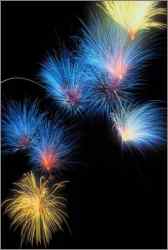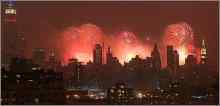|
|

|

The Biggest Firework Display? How Many Used Yearly?
And More Fireworks Facts
by www.SixWise.com
The Fourth of July is just around the corner, and other than watermelon and barbecued burgers what's on everyone's mind is, of course, fireworks.
|

Deep blue and bright white fireworks are the most difficult to produce, according to the American Pyrotechnics Association.
|
This American tradition has much older roots than most people know, and actually didn't originate in America at all. In fact, it's said that the first fireworks came from China in the 800s, when bamboo shoots were filled with gunpowder and set off at the New Year to ward off evil spirits.
What else do you not know, but secretly want to, about fireworks?
-
Macy's department store in New York City claims to hold the world's largest fireworks display. Every year at 9 p.m. on July 4, four barges in the East River, set just between 23rd and 42nd streets, set off 20,000 aerial shells and special effects. The New York Fire Department also operates "fire boats" on the river that shoot red, clear and blue water 300 feet into the air.
-
Many fireworks are actually made in China. In 2006, China exported nearly $212 million worth of fireworks to the United States, according to U.S. trade data.
-
In 2007, Americans used nearly $266 million pounds of fireworks, according to the American Pyrotechnics Association (APA); about $239 million pounds were used by consumers, and 27 million pounds for displays.
-
The U.S. fireworks industry brought in $930 million in revenues in 2007, up from $350 million in 1997, according to APA.
-
Cherry bombs, M-80's, and silver salutes are examples of three fireworks that have been banned in the United States. They were banned in 1966 for containing large amount of explosives.
-
The legal limit of explosive material allowed in a consumer firework is 50 mg (about the size of half an aspirin tablet), according to APA. Any item containing more than 50 mg is illegal.
|

An estimated 3 million people will watch Macy's fireworks display in New York City on July 4, 2008.
|
-
Five states have banned all consumer fireworks (Delaware, Massachusetts, New Jersey, New York, Rhode Island)
-
Arizona allows only "novelty" fireworks
-
Five states allow only sparklers and/or other novelty fireworks (Illinois, Iowa, Maine, Ohio and Vermont)
-
The dazzling displays of color during fireworks occur because of different chemicals added to the gunpowder. According to APA, the mark of an expert pyrotechnician are deep blues and white bursts.
-
In 2006, 11 people died and an estimated 9,200 were treated in emergency departments for fireworks-related injuries in the United States, according to the Centers for Disease Control and Prevention (CDC). About one out of every three people injured were children under 15.
-
Between June 16 and July 16, 2006, the CDC reports that the body parts most often injured by fireworks were hands (2,300 injuries), eyes (1,500 injuries), and the head, face, and ear (1,400 injuries). More than half of the injuries were burns.
-
Which fireworks are most dangerous? According to the CDC, firecrackers, followed by sparklers and rockets caused the greatest numbers of injuries between June 16 and July 16, 2006. However, one-third of fireworks-related deaths between 2000 and 2005 were caused by professional fireworks illegally sold to consumers.
Fireworks Safety Tips
If you're planning to celebrate this Independence Day with a few fireworks of your own, here are tips to keep you safe from the U.S. Consumer Product Safety Commission:
-
Do not allow young children to play with fireworks under any circumstances. Sparklers, considered by many the ideal "safe" firework for the young, burn at very high temperatures and can easily ignite clothing. Children cannot understand the danger involved and cannot act appropriately in case of emergency.
-
Older children should only be permitted to use fireworks under close adult supervision. Do not allow any running or horseplay.
-
Light fireworks outdoors in a clear area away from houses, dry leaves or grass and flammable materials.
-
Keep a bucket of water nearby for emergencies and for pouring on fireworks that don't go off.
-
Do not try to relight or handle malfunctioning fireworks. Douse and soak them with water and throw them away.
-
Be sure other people are out of range before lighting fireworks.
-
Never ignite fireworks in a container, especially a glass or metal container.
-
Keep unused fireworks away from firing areas.
-
Store fireworks in a dry, cool place. Check instructions for special storage directions.
-
Observe local laws.
-
Never have any portion of your body directly over a firework while lighting.
-
Don't experiment with homemade fireworks.
Recommended Reading
Rip Currents & Other Hidden Hazards Everyone Who Swims and Plays in Oceans or Lakes Needs to Know
12 Things NOT to Do in the Summer Heat
Sources
Centers for Disease Control and Prevention: Fireworks-Related Injuries
American Pyrotechnics Association
International Herald Tribune
Consumer Product Safety Commission
FactMonster.com
To get more information about this and other highly important topics, sign up for your free subscription to our weekly SixWise.com "Be Safe, Live Long & Prosper" e-newsletter.
With every issue of the free SixWise.com newsletter, you’ll get access to the insights, products, services, and more that can truly improve your well-being, peace of mind, and therefore your life!
|
|
|
|